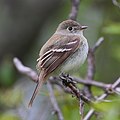| Empidonax | |
|---|---|

| |
| Alder flycatchers, Empidonax alnorum | |
| Scientific classification | |
| Domain: | Eukaryota |
| Kingdom: | Animalia |
| Phylum: | Chordata |
| Class: | Aves |
| Order: | Passeriformes |
| Family: | Tyrannidae |
| Genus: | Empidonax Cabanis, 1855 |
| Type species | |
| Empidonax pusillus[1] Cabanis, 1855
| |
| Species | |
|
See text | |
The genus Empidonax is a group of small insect-eating passerine birds in the tyrant flycatcher family, the Tyrannidae. The genus name Empidonax is from Ancient Greek empis, "gnat", and anax, "master".[2]
Most of these birds are very similar in plumage: olive on the upper parts with light underparts, eye rings and wing bars. In the nesting season they may be distinguished by range, habitat and call; in other situations, particularly on migration and in winter, it may not be possible to be sure of specific identification.
Empidonax flycatchers often flick their wings and tails rapidly.
Euler's flycatcher, Lathrotriccus euleri and gray-breasted flycatcher, Lathrotriccus griseipectus were formerly placed in Empidonax, but differ anatomically and biochemically and are now placed in the genus Lathrotriccus.
Species[edit]
The genus contains 14 species:[3]
| Image | Scientific name | Common Name | Distribution |
|---|---|---|---|
 |
Empidonax flaviventris | Yellow-bellied flycatcher | North America, Mexico and Central America |
 |
Empidonax virescens | Acadian flycatcher | eastern United States and southwestern Ontario, eastern Mexico and the Caribbean to southern Central America and the very northwest of South America in Colombia, western Venezuela, and Ecuador |
 |
Empidonax alnorum | Alder flycatcher | Canada and Alaska, descending to a southernmost point in the northeastern United States |
 |
Empidonax traillii | Willow flycatcher | United States and southern Canada |
 |
Empidonax albigularis | White-throated flycatcher | Belize, Costa Rica, El Salvador, Guatemala, Honduras, Mexico, Nicaragua, and Panama. |
 |
Empidonax minimus | Least flycatcher | eastern North America |
 |
Empidonax hammondii | Hammond's flycatcher | western United States, Alaska and Canada |
 |
Empidonax wrightii | American grey flycatcher | western North America, especially the Great Basin. |
 |
Empidonax oberholseri | American dusky flycatcher | southern Arizona and Mexico |
 |
Empidonax affinis | Pine flycatcher | Mexico and southwestern Guatemala. |
 |
Empidonax difficilis | Western flycatcher | western North America, including the Pacific Ocean and the southern Gulf of California to Mexico |
 |
Empidonax flavescens | Yellowish flycatcher | southeastern Mexico south to western Panama. |
 |
Empidonax fulvifrons | Buff-breasted flycatcher | United States through Mexico to southern Honduras. |
 |
Empidonax atriceps | Black-capped flycatcher | Costa Rica and western Panama. |
References[edit]
- ^ "Tyrannidae". aviansystematics.org. The Trust for Avian Systematics. Retrieved 2023-07-16.
- ^ Jobling, James A (2010). The Helm Dictionary of Scientific Bird Names. London: Christopher Helm. p. 146. ISBN 978-1-4081-2501-4.
- ^ Gill, Frank; Donsker, David, eds. (2019). "Tyrant flycatchers". World Bird List Version 9.2. International Ornithologists' Union. Retrieved 29 June 2019.

Well, that’s interesting to know that Psilotum nudum are known as whisk ferns. Psilotum nudum is the commoner species of the two. While the P. flaccidum is a rare species and is found in the tropical islands. Both the species are usually epiphytic in habit and grow upon tree ferns. These species may also be terrestrial and grow in humus or in the crevices of the rocks.
View the detailed Guide of Psilotum nudum: Detailed Study Of Psilotum Nudum (Whisk Fern), Classification, Anatomy, Reproduction